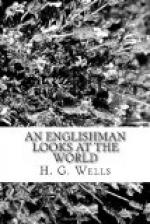But that is a scheme too comprehensive and rational for the ordinary student of the London traffic problem, whose mind runs for the most part on costly and devastating rearrangements of the existing roadways. Moreover, it would probably secure a maximum of effect with a minimum of property manipulation; always an undesirable consideration in practical politics. And it would commit London and England to goods transit by railway for another century. Far more attractive to the expert advisers of our various municipal authorities are such projects as a new Thames bridge scheme, which will (with incalculable results) inject a new stream of traffic into Saint Paul’s Churchyard; and the removal of Charing Cross Station to the south side of the river. Then, again, we have the systematic widening of various thoroughfares, the shunting of tramways into traffic streams, and many amusing, expensive, and interesting tunnellings and clearances. Taken together, these huge reconstructions of London are incoherent and conflicting; each is based on its own assumptions and separate “expert” advice, and the resulting new opening plays its part in the general circulation as duct or aspirator, often with the most surprising results. The discussion of the London traffic problem as we practise it in our clubs is essentially the sage turning over and over again of such fragmentary schemes, headshakings over the vacant sites about Aldwych and the Strand, brilliant petty suggestions and—dispersal. Meanwhile the experts intrigue; one partial plan after another gets itself accepted, this and that ancient landmark perish, builders grow rich, and architects infamous, and some Tower Bridge horror, some vulgarity of the Automobile Club type, some Buckingham Palace atrocity, some Regent Street stupidity, some such cramped and thwarted thing as that new arch which gives upon Charing Cross is added to the confusion. I do not see any reason to suppose that this continuous muddle of partial destruction and partial rebuilding is not to constitute the future history of London.
Let us, however, drop the expert methods and handle this question rather more rudely. Do we want London rebuilt? If we do, is there, after all, any reason why we should rebuild it on its present site? London is where it is for reasons that have long ceased to be valid; it grew there, it has accumulated associations, an immense tradition, that this constant mucking about of builders and architects is destroying almost as effectually as removal to a new site. The old sort of rebuilding was a natural and picturesque process, house by house, and street by street, a thing as pleasing and almost as natural in effect as the spreading and interlacing of trees; as this new building, this clearance of areas, the piercing of avenues, becomes more comprehensive, it becomes less reasonable. If we can do such big things we may surely attempt bigger things, so that whether we want to plan a new capital or preserve




